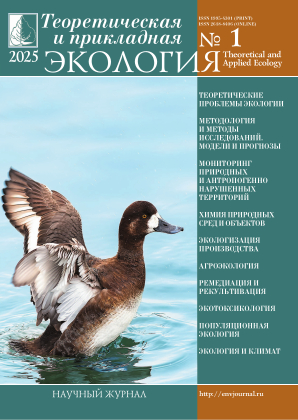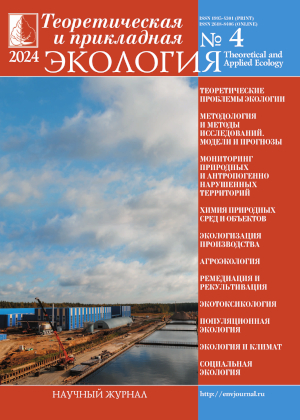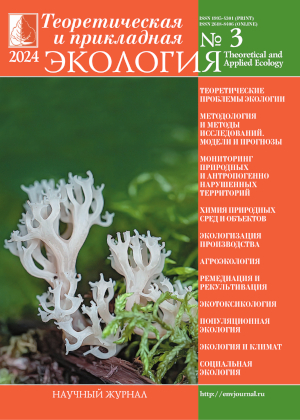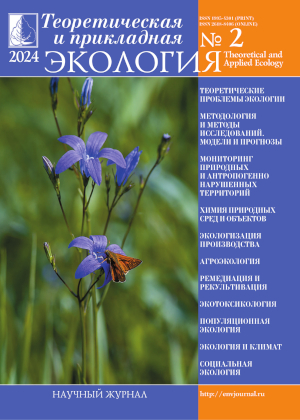 ISSN 1995-4301
ISSN 1995-4301(Print)
ISSN 2618-8406
(Online)
Online version of the journal
|
Kahakamide A isolated from Nocardiopsis dassonvillei Tb8 novel strain is a DNA gyrase inhibitor |
||||
| J.A. Buyuklyan, Yu.V. Zakalyukina, A.R. Belik, V.A. Alferova, I.A. Osterman, M.V. Biryukov | ||||
| Section: Methodology and research methods. Models and forecasts |
||||
| The search for new biologically active substances as well as the study of the mechanisms of action of previously described antimicrobial metabolites, still remain priority areas of fundamental chemical and biological research, since the results of such work can help in overcoming the growing antibiotic resistance of pathogenic microorganisms. Modern approaches to search for bioactive compounds using high-throughput screening methods make it possible to discover and study new compounds with high speed and accuracy. An example of such a system is a genetically modified Escherichia coli strain containing the plasmid vector pDualrep2. This genetic construction allows the detection of the antibacterial activity of compounds and the mechanism of action of a specific metabolite. During the search for strains producing promising substances for antimicrobial therapy using the pDualrep2 reporter system, Nocardiopsis dassonvillei strain Tb8, isolated from soil in a tobacco field (Razdolnaya village, Krasnodar Krai) was identified. The produced metabolite of strain Tb8 causes growth suppression of E. coli with tolC gene deletion and induction of SOS-response in bacterial cells. The isolated and purified active substance was identified by HPLC-ESI-qTof as Kahakamide A. The mechanism of action of Kahakamide A through inhibition of DNA synthesis has not been previously described, and for the first time we found the activity of this substance against Klebsiella pneumoniae ATCC 700603, K. pneumoniae ATCC 62867, E. coli ATCC 35705 strains with clinically significant resistance to beta-lactams. The above makes this substance and the target of its action promising for the development of therapeutic drugs. A detailed study of Kahakamide A biosynthesis will be the subject of further research. | ||||
| Keywords: search for antibiotics, kahakamide A, actinomycetes, strain Nocardiopsis dassonvillei Tb8 |
||||
| Article published in number 1 for 2025 DOI: 10.25750/1995-4301-2024-4-049-061 |
||||
|
||||
Transgenic tomato (Solanum lycopersicum L.) rhizosphere bacterial community structure |
||||
| А.А. Antonov, А.А. Vankova, E.N. Baranova, L.V. Kurenina, Е.V. Platonova | ||||
| Section: Agroecology |
||||
| The cultivation of genetically modified plants may involve risks to the environment, including soil microorganisms that perform important biospheric functions. The work used transgenic tomato (Solanum lycopersicum L.) of a breeding line obtained from the Yamal variety, with the codA choline oxidase synthesis gene encoding resistance to osmotic stress. Plants of the same breeding line of the original variety used as control. After 20 weeks of cultivation in a soil culture, amplicon sequencing of 16S rRNA of total DNA from the rhizosphere was performed. Analysis of the taxonomic diversity and structure of the bacterial community of the rhizosphere showed an increase in the proportion of the Proteobacteria dominant phylum (from 62 to 64%) and a decrease in Bacteroidetes (from 19 to 17%) in transgenic plants compared with the control. The classes Spartobacteria and Chloroflexia present in control plants were not detected in the rhizosphere of genetically modified plants. Classes Caldilineae and Holophagae absent in the rhizosphere of control plants were detected. Taxonomic analysis at the generic level revealed in genetically modified plants a decrease in the share of the gg Sphingomonas, Rhizomicrobium, Pseudolabris (by 0.6–1.2%) and an increase in the relative abundance of the gg Deviosia and Bauldia (by 1.2–1.3%). The gg Sphingobium and Pedomicrobium present in control plants were undetected in the rhizosphere of transgenic plants, and the gg Micavibrio and Chryseolinea were found out. The Shannon diversity index was 8.62 and 8.77, Chao1 – 1075 and 1122 in control and transgenic plants, respectively. The revealed changes in the composition and structure of the bacterial complex in the rhizosphere of the studied transgenic plants may lead to disruption of the functions of the soil microbial system. | ||||
| Keywords: bacteria, rhizosphere, tomato, transgenic plants, choline oxidase |
||||
  |
||||
| Article published in number 1 for 2025 DOI: 10.25750/1995-4301-2024-4-151-157 |
||||
|
||||
The butterfly (Lepidoptera, Rhopalocera) abundance of meadow ecosystems in the southern taiga |
||||
| A.V. Mazeeva, A.G. Tatarinov, O.I. Kulakova | ||||
| Section: Population ecology |
||||
| The article considered the structure of butterfly abundance, based on the ratio of the butterfly adults number in the meadow ecosystems in the Kirov Region southern taiga. 65 butterfly species (56% Papilionoidea species of Kirov region’s southern taiga) were recorded in the 16 meadows. The composition of the background butterfly species of the studied meadows was identified from regular transects counts over several years from May to August inclusive (Pollard walk). In the remaining meadows the background species consisted of two to four species in different combinations. Three main types topical groups were identified on the results of analysing background species combinations, percentages, and estimates of their relative abundance on a logarithmic scale. They were conventionally designated according to the main background species: type idas/argus, type lineola, and type hyperantus. In additon two “intermediate” groups were established. The first one is jointly dominated by Aphantopus hyperantus and Thymelicus lineola, while the second one presents three subdominants – Plebeius idas/argus, Pieris napi, and Th. lineola – without a clear leader in abundance. A stable relationship between the butterfly abundance structure and vegetation cover was noted. We also identified external factors affecting this dependence. This paper shows the role of ant nests in the formation of the butterfly abundance structure in meadow habitats, that determines the Papilionoidea topical groups’ existence in the studied area. A high number of ant nests in the sites increases the P. idas/ argus relative abundance. This relationship is confirmed by one-way ANOVA and correlation analysis. | ||||
| Keywords: Papilionoidea, Kirov Region, southern taiga, abundance of meadow ecosystems, topical groups of species |
||||
    |
||||
| Article published in number 1 for 2025 DOI: 10.25750/1995-4301-2024-4-177-186 |
||||
|
||||
Ecological and toxicological evaluation of the possibility of selenium application for the correction of lead intoxication in Wistar rats |
||||
| A.V. Sindireva, O.A. Zaуko, A.K. Mangutova | ||||
| Section: Ecotoxicology |
||||
| Excessive intake of heavy metals (HM) into the diet of animals and humans with plant food and water is due to water, soil, and plants contamination with HM. In this regard, it seems relevant to develop new methods and study of biochemical mechanisms of detoxification in the body. The use of antagonist elements, in particular selenium, deserves special attention. To assess the possibility of selenium application for correction of metabolic disorders caused by toxic doses of lead in the body, a subacute experiment was conducted for 14 days on male Wistar rats. The animals were divided into four groups of 15 rats each. The first group was the control (intact animals). The experimental groups “Se”, “Pb”, “Pb+Se” received daily oral administration of 1 mg/kg lead or/and selenium compounds. After the experiment, the organs of the animals were examined for selenium content using a fluorometric method. The blood plasma was examined for the content of biochemical indicators characterizing liver and kidney function, as well as the content of substances with low and medium molecular weight. The activity of antioxidant enzymes and indicators of lipid peroxidation were determined in the liver and kidney homogenates. Our results showed that changes in liver and kidney function in the “Se” and “Pb” groups were associated with impaired energy metabolism, hypoxia, and oxidative stress, leading to intensified peroxidation processes and disruption of organ membrane structures. The administration of selenium-containing compounds on the background of lead compounds promotes activation of the antioxidant system. However, both hypoxia and impaired energy metabolism are still observed, as evidenced by increased levels of lactate, glucose, and aspartate aminotransferase activity. The results contribute to understanding the biochemical aspects of lead and selenium action in animals. The obtained data can serve as a basis for developing pathogenetically justified methods for correcting micronutrient imbalances based on the interaction between selenium and HM. | ||||
| Keywords: lead, selenium, liver, kidneys, trace elemental deseases, metabolism |
||||
| Article published in number 1 for 2025 DOI: 10.25750/1995-4301-2024-4-168-176 |
||||
|
||||
Geo-ecological aspects of sustainable development of multifunctional complexes for solid municipal waste management |
||||
| E.V. Gubar, O.A. Samarina, O.V. Tupicina, V.N. Pystin | ||||
| Section: Monitoring of natural and anthropogenically disturbed areas |
||||
| This study is devoted to solving the problems of creating (new construction) municipal solid waste management (MSW) facilities on the territory of small settlements (municipal districts and regions) of the Volga Federal District. The most significant geo-ecological indicators providing a comprehensive assessment of the design and construction of a MSW landfill were identified and justified. Service life, capacity, landfill capacity for non-compacted waste, and landfill capacity for compacted waste are the main indicators. The technical indicators of the design objects are a set of main and auxiliary facilities serving the operation of the waste disposal site in accordance with its functional zoning. A comparative assessment of the geo-ecological, technical, economic and operational indicators of the construction of a MSW disposal facility was carried out by developing three options for organizing a waste disposal site (quarry, bulk, combined) for a reference landfill of solid municipal waste with a disposal capacity of up to 30 thousand tons per year with a storage area of 3 hectares. The degree of economic activity effect on the geological environment is considered from the maximum possible deepening to the refusal of deepening of MSW landfill site. The quantitative parameters obtained as a result of the study represent criteria for redundancy of design solutions as a percentage of the total cost of construction of waste management facilities. The calculations made it possible to develop an integrated system for assessing technical and economic indicators and resource and technological security of design solutions for measures implemented in the sphere of consumer waste management. | ||||
| Keywords: sustainable development of municipal MSW facilities, rational use of land resources, environmental safety of natural-technogenic systems, geo-ecological assessment of the construction of municipal MSW facilities |
||||
| Article published in number 1 for 2025 DOI: 10.25750/1995-4301-2024-4-111-119 |
||||
|
||||
Maximum age of Coregonus lavaretus in the Pechora River basin |
||||
| E.I. Boznak, V.I. Ponomarev | ||||
| Section: Population ecology |
||||
| The work analyzes data on the maximum recorded age of Coregonus lavaretus caught in different water bodies of the Pechora River basin (a total of 1948 specimens from 12 rivers, 18 different types of lakes and Korovinskaya Bay of the Pechora Sea). Field collections of materials were carried out in the period from 1985 to 2022. In different samples, the maximum age varied from 5+ to 21+. Residential groups are characterized by higher maximum age (5+ – 21+, median 9) compared to the semi-anadromous form of whitefish (5+ – 9+, median 8). The highest values (18+ and 21+) were recorded for whitefish living in hard-to-reach reservoirs of the lake-river system of the Maly Patok River (a second-order tributary of the Pechora River). The catchment area of this river is entirely part of the territory of the Federal National Park “Yugyd va”, included in the UNESCO World Heritage List. Today, this age is apparently the maximum for whitefish in water bodies of the European Northeast of Russia and is close to the limit values for this fish species. The theoretical age limit for whitefish varies from 12 to 44 years (on average about 25 years) and describes the linear growth of whitefish in different reservoirs of the Pechora River basin. It was estimated on the basis of the coefficients of the Bertalanffy equation (k and t0). A similar value (28–35 years) is obtained if the calculations use seven times the duration of maturation period (4+ – 5+ years). There are no significant differences in the maximum theoretical age between the semi-anadromous and residential forms of the whitefish. The maximum recorded ages of Pechora whitefish (17+ – 21+) can reach 70–80% of theoretical values. Apparently, the main factor limiting the lifespan of whitefish in natural reservoirs is intensive fishing. | ||||
| Keywords: Coregonus lavaretus, maximum age, the Pechora River basin |
||||
  |
||||
| Article published in number 1 for 2025 DOI: 10.25750/1995-4301-2024-4-187-193 |
||||
|
||||
Heavy metal accumulation in soils and leaves of Betula pendula in urban pollution conditions |
||||
| A.S. Petukhov, T.A. Kremleva, E.D. Levchuk, N.A. Khritokhin, G.A. Petukhova | ||||
| Section: Monitoring of natural and anthropogenically disturbed areas |
||||
| The main aim was to study heavy metal (Cu, Zn, Fe, Mn, Pb, Cd, Ni, Co, Cr) migration in soil-birch (Betula pendula) system, as well as to determine the contribution of metal aerotechnogenic migration to their total accumulation by birch leaves. Soils and birch leaves were sampled near industrial enterprises and transport hubs in Tyumen. The mobile and acid-soluble metal fraction content in soils, as well as metal content in washed and unwashed birch leaves were determined by atomic emission spectroscopy. Metal accumulation in urban soils compared to the control decreased in the order: Cd>Pb>Cr>Ni>Zn>Cu>Fe>Co>Mn. Pb and Ni content exceeded the MPC. Metal accumulation in birch leaves decreased in the order: Pb>Cr>Fe>Co>Cu>Ni>Zn>Mn>Cd. Pb, Zn, Ni, Fe, and Cr content exceeded the MPC. The greatest metal accumulation in soil was at railway station, while in birch leaves – in the vicinity of metallurgical plant. Metal mobility in soil decreased in the order Cd>Pb>Mn>Zn>Ni>Co>Cu>Cr>Fe, which correlated with their bioavailability: Zn>Cd>Mn>Cu>Ni>Pb>Cr>Fe>Co. The contribution of aerotechnogenic metal migration studied by the difference of metal content in washed and unwashed leaves, was 20-30%. Aerotechnogenic migration decreased in the order: Cr>Ni>Cd≈Mn>Fe>Zn≈Pb≈Co>Cu. The correlation between aerotechnogenic migration and metal compounds volatility was established. | ||||
| Keywords: heavy metals, soils, plants, aerotechnogenic migration, bioconcentration factor, accumulation |
||||
| Article published in number 1 for 2025 DOI: 10.25750/1995-4301-2024-4-083-091 |
||||
|
||||
Post-pyrogenic soils of the Chara Depression larch forests (North Transbaikalia) |
||||
| Yu.K. Vasil’chuk, A.P. Ginzburg, A.C. Vasil’chuk, N.A. Budantseva, J.Yu. Vasil’chuk | ||||
| Section: Chemistry of natural environments and objects |
||||
| We looked at the soil profiles on the first Holocene terrace of the Chara River, where the Belen’kiy stream flows into it (Transbaikalia, Russia), to find out how wildfires change the post-pyrogenic soil properties in the intermontane depressions of North Transbaikalia. In 1994 and 2019 forest fires affected the soil. Studied soils were classified as gleysols of the permafrost subtype (Cryosols Reductaquic Pyric). All soils showed signs of pyrogenesis. Values of pHwater varied within the range of 3.9–5.1, pHKCl – varied from 3.5 to 4.9, and hydrolytic acidity varied from 3.3 to 4.5 cmol(+)/kg. Thus, the pyrogenic process did not impact the soil solution pH significantly. Total organic carbon content, which reached 8.7% in post-pyrogenic soil horizons, probably increased as a result of vegetation combustion. Soils have a lot of particles with sizes between 0.01% and 0.025 mm (more than 35%), and after the fire, the post-pyrogenic horizons lose most of the fine particles (<0.01 mm). The leaching of Si, Al, Sr, Zr, and Rb is an explicit indication of wildfire transformation. The radial differentiation coefficients of macroelements were 0.5–0.7 (Al) and 0.7–0.9 (Si) in the soil profiles. Recently burnt soil horizons were characterized by the depletion of trace elements (RSr=0.2, RZr=0.2, RRb=0.8), however in the older post-pyrogenic horizon, oppositely, the strong accumulation of these trace elements was observed: RSr=4.0, RZr=7.7, RRb=3.1. These data will aid in determining the influence of pyrogenic factors on the physical and chemical characteristics of soils exposed to combustion. | ||||
| Keywords: physical and chemical soils properties, forest fires, post pyrogenic transformation, profile distributions |
||||
| Link | ||||
   |
||||
| Article published in number 1 for 2025 DOI: 10.25750/1995-4301-2024-4-130-139 |
||||
|
||||
The condition of tree stands in middle taiga Piceetum myrtillosum on automorphic soils in the plots affecting by aerotechnogenic pollution from the timber industry complex (the Komi Republic) |
||||
| A.V. Manov, E.A. Robakidze | ||||
| Section: Monitoring of natural and anthropogenically disturbed areas |
||||
| The authors accessed the effect of aerotechnogenic emissions from the pulp-and-paper plant of the Syktyvkar timber industry complex on the condition of spruce stands. Carbon monoxide, nitrogen dioxide, inorganic dust, hydrogen sulfide, sulfur dioxide and mercaptans are the main pollutants. By the radial growth dynamics of spruce stem wood we identified the development trend of forest stands affected by the long-term technogenic impact. The old-growth blueberry spruce forests located at distances of 4, 5, 11, 24, 50 km from the emission source in the direction of prevailing winds were studied. The vitality of spruce forest stands has been analyzed via visual evaluation of tree crowns at the sample plots. The studied spruce stands are ‘healthy’ with initial weakening signs which slightly intensify towards the discharge chimneys of the enterprise. the impact of aerotechnogenic emissions from pulp-and-paper production on the radial increment of spruce stem wood was assessed by the tree-ring indication methods. The study by this methods has utilized wood samples (cores) taken from trunks of old-growth spruce trees within sample plots. Finally, we have identified the increased radial growth of spruce in the impact zone. At distances longer than 11 km from the air pollution source, the radial growth of spruce stem wood resists relatively stable from the very beginning of the timber industry enterprise (from 1969 to the present). The increase in radial growth of spruce trees is associated to the time when the enterprise attained its installed capacity in the late 1980s. This was followed by a long-time decrease in radial growth of trees. This period is characterized by a production decline due to the deterioration of the financial situation in Russia during the 1990s and production modernization from 2008 to 2018 which reduced gas and dust emissions of the enterprise. | ||||
| Keywords: life condition, destruction, tree-ring indication, aerotechnogenic pollution, pulp and paper production, stem wood radial growth, Piceetum myrtillosum, middle taiga |
||||
 |
||||
| Article published in number 1 for 2025 DOI: 10.25750/1995-4301-2024-4-073-083 |
||||
|
||||
Specifics of the bottom biogeocenosis formation on tidal flats of the White Sea mesotidal estuaries |
||||
| I.V. Miskevich, N.M. Makhnovich, O.P. Netsvetaeva | ||||
| Section: Monitoring of natural and anthropogenically disturbed areas |
||||
| We studied the peculiarities of bottom biogeocenoses formation on tidal flats of mesotidal estuaries (case-study of the Tamitsa River estuary in the Onega Bay of the White Sea). Mesotidal estuaries that dominate in the White Sea are characterized by extensive tidal flats and the highest tide of 1.7–2.8 m. Such habitats are currently very poorly understood. In May 2022, expedition works were carried out in the Tamitsa River estuary. Quantitative zoobenthos development parameters and organic matter content in benthic sediments identified by chemical oxygen demand were determined at five sites on the tidal flat. It is shown that the sorting of suspended sediments by hydraulic coarseness in the estuary water entails the formation of relatively narrow bands enriched or depleted in organic content. Such bands stretch along the shoreline and are confined to water levels close to low and high water of the tidal cycle. The characteristic width of bottom sediment bands enriched with organic matter with the presence of a large number of benthic animals is several meters. It depends largely on the difference in tidal magnitude during different phases of the moon-solar cycle. The extent of the above mentioned bands will depend on the geomorphology of the river mouth. If we focus on mesotidal estuaries of minor rivers of the White Sea, their characteristic length should be from several hundred meters to 1–3 km. Bivalves and polychaetes dominate in the bands with maximum biomass of benthic invertebrates, while crustaceans and some species of bivalves dominate in the zones with minimum biomass. It is recommended to take into account the possibility of accumulation of highly toxic pollutants, such as organochlorine and organophosphorus pesticides, biphenyls and a number of heavy metals, in monitoring of bottom sediment pollution in tidal estuaries. | ||||
| Keywords: minor river, estuary, tidal flats, zoobenthos, chemical oxygen demand |
||||
    |
||||
| Article published in number 1 for 2025 DOI: 10.25750/1995-4301-2024-4-105-110 |
||||
|
Pages: previous 1
|
36, Moskovskya street, Kirov, 610000, Editorial Board "Theoretical and Applied Ecology." Phone/fax: (8332) 37-02-77 e-mail: envjournal@vyatsu.ru The journal was founded in 2007 |
||||||




 Select viewing options
Select viewing options